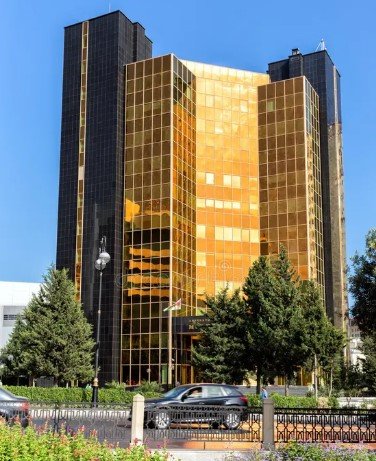Economic growth is cooling, oil’s losing steam, and consumer loans may be getting a bit too hot
Azerbaijan’s banking sector has come a long way since the bad old days of 2017, but its rising comfort could come at a price. A new report by Fitch Ratings says performance metrics are broadly better, yet fresh risks are bubbling just beneath the surface—especially in retail lending.
As the country’s economy slows down after years of oil-fueled growth, lenders may be pushing too hard on consumer credit, raising fears of overheating even as the central bank scrambles to keep things under control.
Growth Is Slipping, and Oil’s No Longer the Backstop
Azerbaijan’s economy isn’t crashing—but it’s definitely downshifting.
Fitch now expects GDP growth to drop to 3.5% in 2025, and slow further to 2.5% in 2026, down from 4.1% in 2024. The culprit? A less buoyant oil and gas sector, pressured by softening global energy prices.
That’s a big deal in Baku, where hydrocarbon revenues are still a dominant force.
But it’s not all bad news.
The rating agency praised the country’s overall macro framework and said key metrics are healthier than they’ve been in years. Since 2017, Azerbaijan has trimmed down its dollarization problem—a longstanding vulnerability for its banks. It’s also cleaned up a chunk of poor-quality legacy assets that once clogged up balance sheets.
Still, the warning signs are flashing on a different front now.

Retail Lending Is Booming—Maybe a Bit Too Fast
Households are borrowing more than ever, and banks are more than happy to oblige.
Retail lending has soared since 2021, and Fitch says this “rapid expansion” could pose overheating risks, particularly if wages or job growth don’t keep pace.
The Central Bank of Azerbaijan (CBA) isn’t sitting idle. It’s been tightening lending conditions gradually and applying targeted regulatory tools to curb credit growth in high-risk areas.
One sentence here.
But the pace of borrowing is still strong—perhaps too strong.
Here’s a quick look at the change since 2020:
-
Retail loan volume has more than doubled since late 2020, according to CBA data.
-
Consumer debt service ratios in urban centers have climbed close to pre-2015 crisis levels.
-
Over 40% of new personal loans are for non-essential consumption.
“The surge in unsecured retail lending looks familiar,” said one analyst with a regional investment firm. “It’s a pattern we’ve seen elsewhere—until it stops abruptly.”
Banking Sector Health: Stronger on Paper, but Not Invincible
On the surface, banks in Azerbaijan are doing better. Much better, in fact.
They’re sitting on more capital, earning steadier profits, and relying less on foreign-currency loans—a key improvement from the 2015-2017 banking crisis era. Fitch called out several positive signs in its report, including:
| Indicator | 2017 | 2024 | Comment |
|---|---|---|---|
| Dollarisation of Loans | 47% | 29% | Lower FX risk |
| Non-Performing Loans (NPLs) | 14.6% | 4.8% | Improved asset quality |
| Banking Sector Capital Adequacy | 12% | 16.3% | Better buffers in place |
One short sentence.
But beneath the healthy headline numbers, challenges remain. For one, bank profitability is still heavily reliant on interest income, making them vulnerable to any future rate cuts or policy shifts. And while the biggest lenders are relatively solid, smaller institutions remain exposed to credit cycle volatility.
Central Bank Plays Active Risk Manager Role
To its credit, Azerbaijan’s central bank has been unusually proactive in managing sectoral risk—especially in retail lending.
Since 2022, the CBA has implemented several targeted macroprudential measures:
-
Introduced debt-to-income caps for consumer borrowers
-
Tightened loan-to-value ratios on car and household electronics loans
-
Mandated enhanced borrower assessment criteria for banks and non-bank lenders
The CBA has also launched stress tests for commercial banks to model how they’d handle rising defaults in unsecured loan portfolios.
One sentence paragraph here.
Still, there’s only so much monetary policy can do when household borrowing is racing ahead of wage growth.
One analyst close to the central bank said the institution is “worried, but not panicking”—at least not yet.
Public Mood: Salaries Are Up, but So Are Prices
There’s another layer here. Average monthly salaries have grown, reaching AZN 1,095 in 2025, according to the State Statistics Committee. That’s good news, sure, but inflation has also been eating into those gains.
Households feel wealthier—but may not actually be.
Anecdotal reports suggest more people are taking on multiple small loans to finance lifestyle upgrades. Think smartphones, air conditioners, weddings.
The problem is, while one loan is manageable, juggling several can spiral quickly.
One Baku-based loan officer described seeing repeat customers coming back to refinance loans within six months. “It’s becoming common,” he said. “We try to counsel them, but demand is demand.”
External Shocks Could Tip the Balance
Even with local controls, Azerbaijan remains exposed to global financial currents.
Oil prices, currency fluctuations, and regional stability (especially involving neighboring Russia and Iran) all play into credit risk assessments. A renewed oil slump or regional conflict could trigger a wave of defaults, especially among vulnerable borrowers.
That’s why Fitch is watching closely. It doesn’t see a full-blown crisis looming—yet—but the signs are worth paying attention to.
One final short line.
And that makes the central bank’s job even harder in the quarters ahead.








